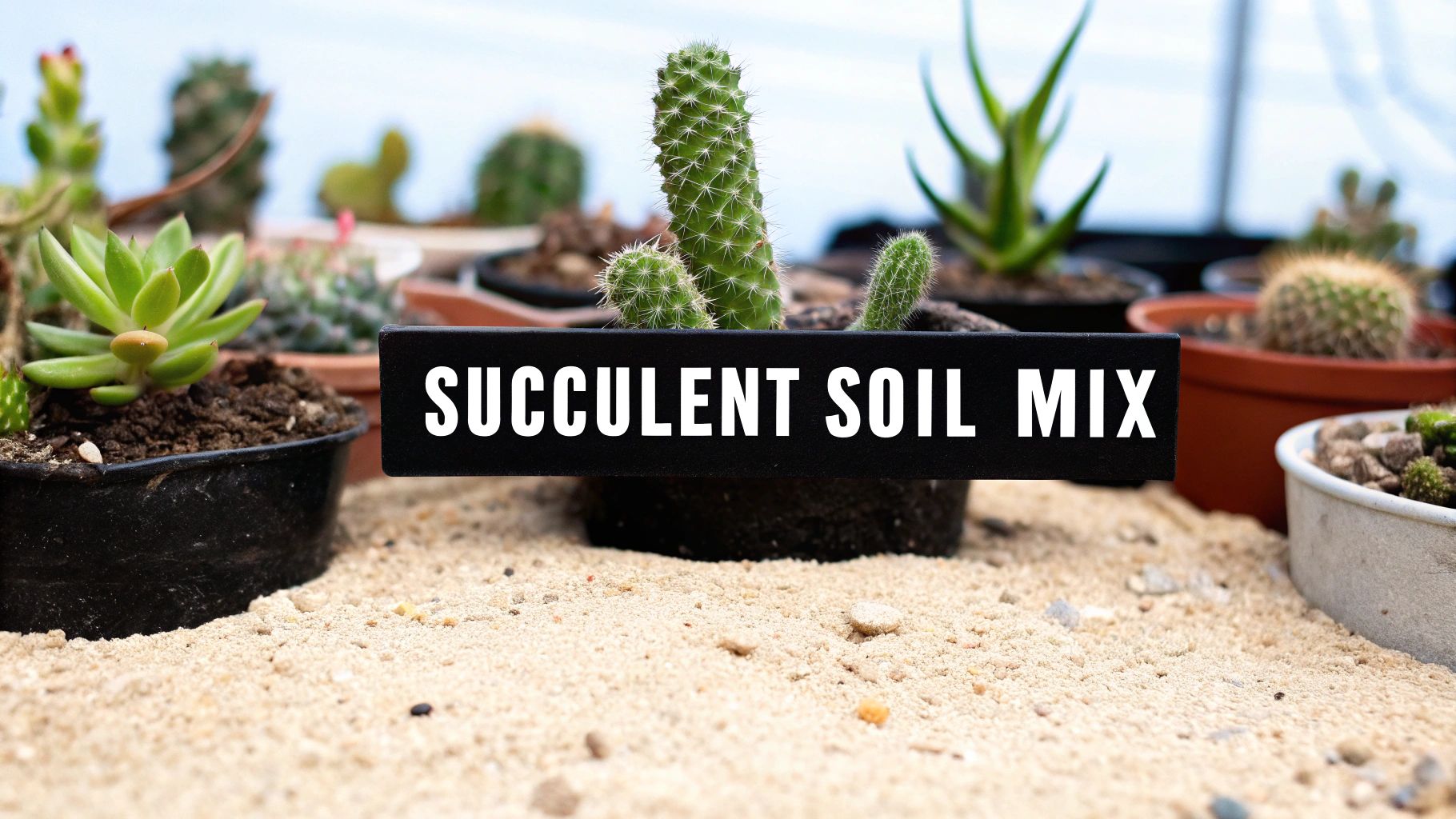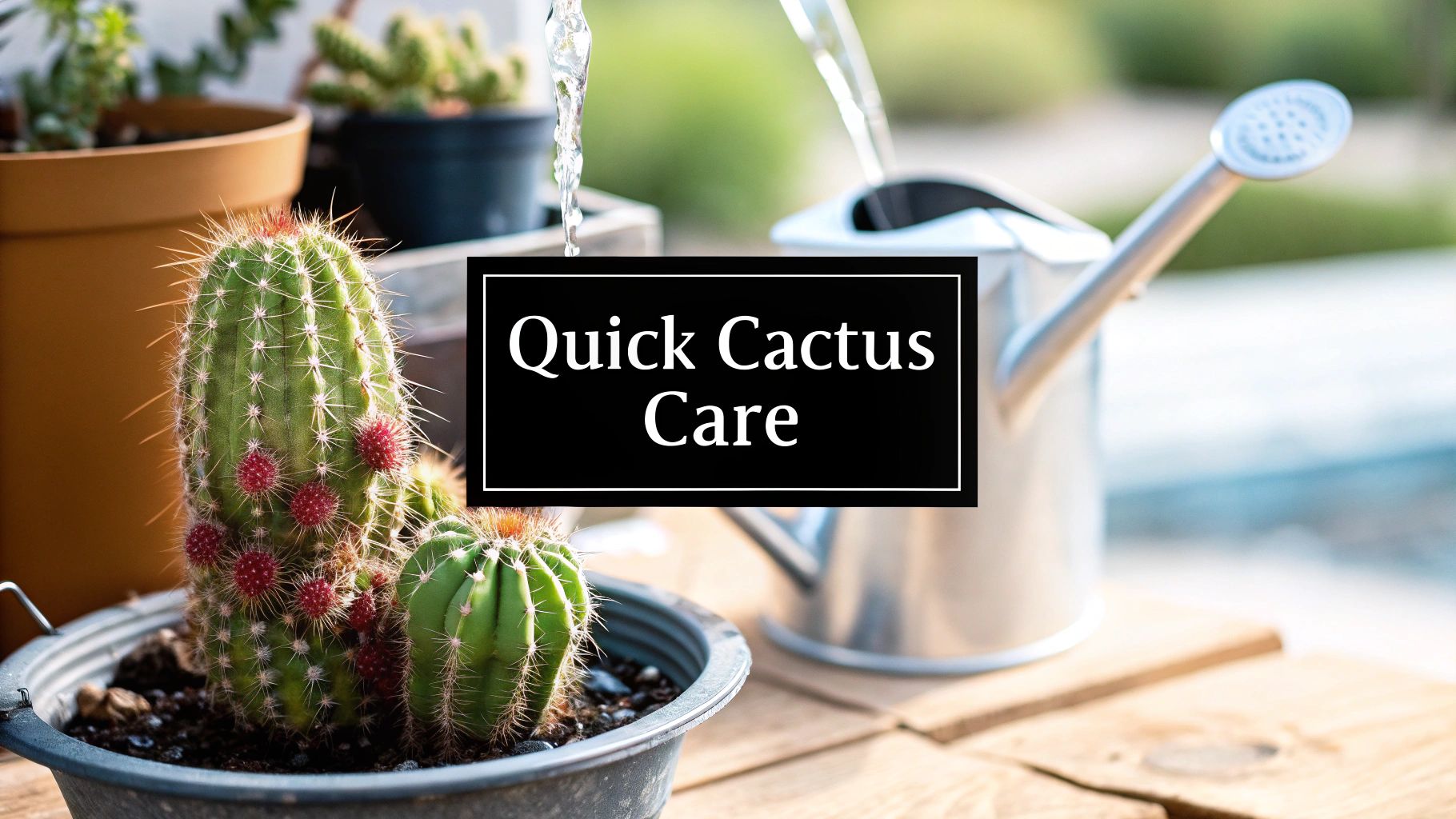If there's one golden rule for watering succulents, it's this: embrace the "soak and dry" method. Think of it as mimicking the desert rainstorms these plants are built for—a heavy downpour followed by a long, dry spell. You drench the soil completely until water streams out the drainage hole, then you wait for it to dry out entirely before even thinking about watering again.
This single technique is the secret to avoiding root rot, the number one killer of succulents.
Getting Succulent Watering Right
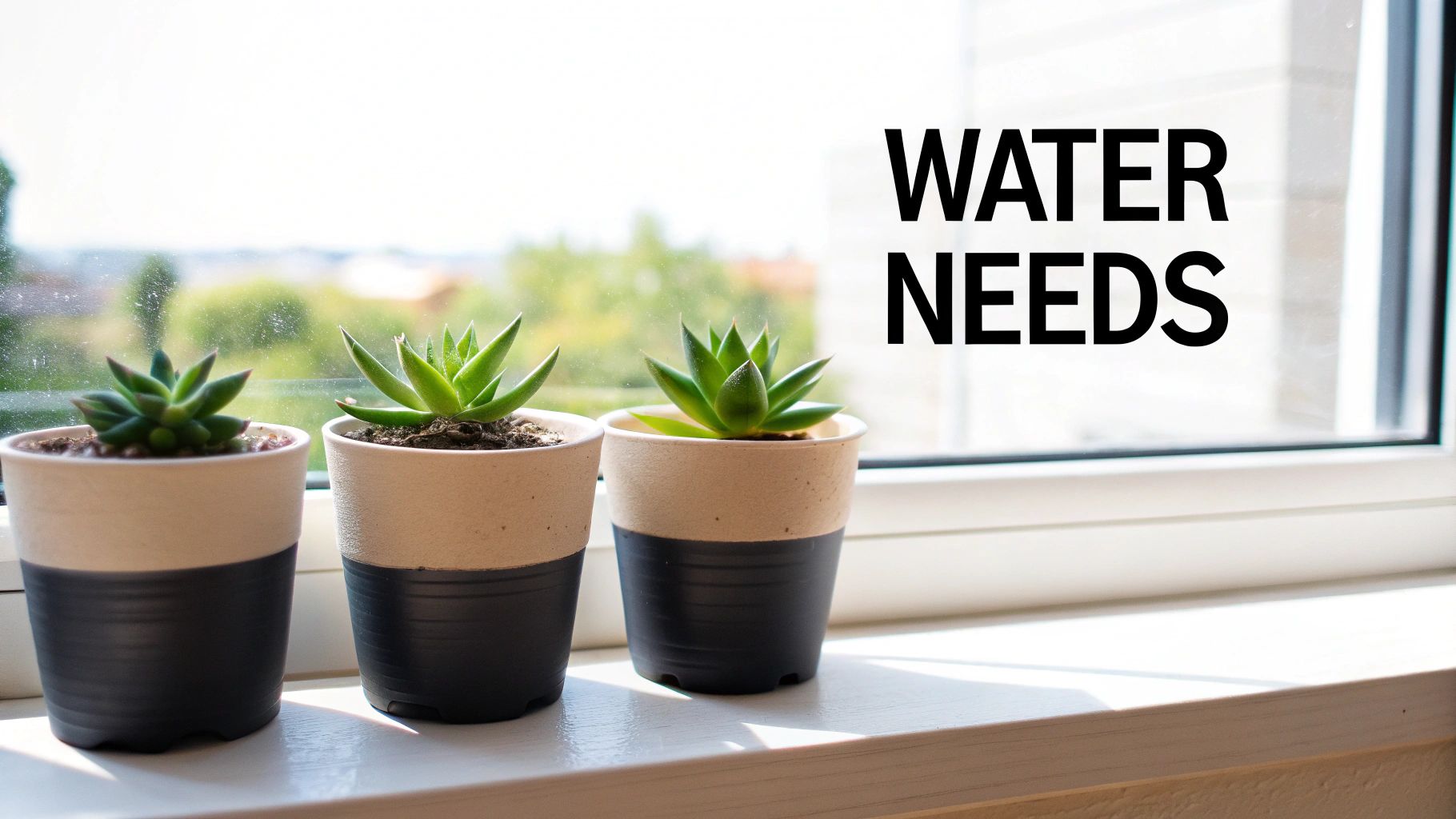
It’s a common mistake I see all the time: new owners giving their succulents little sips of water every few days. This well-intentioned habit is actually one of the worst things you can do. It only moistens the very top layer of soil, which leads to weak, shallow roots that can't properly anchor or nourish the plant.
Worse yet, it keeps the surface soil constantly damp—an open invitation for fungus, gnats, and deadly rot.
The "soak and dry" method does the complete opposite. A deep, thorough soaking encourages the roots to grow down deep into the pot, searching for that moisture. This builds a strong, extensive root system that’s the foundation for a thriving, healthy plant.
Think Like a Succulent
To really nail this, it helps to understand how these amazing plants are designed. Succulents are essentially living water tanks. Their chubby leaves and stems store an incredible amount of water—up to 90-95% of their total weight! This is their survival strategy for arid climates.
Because they hold onto so much water, they don't need the constant watering that other houseplants do. That deep, infrequent watering cycle is what they're truly craving. For a more detailed look, you can get more tips on watering your cacti and succulents.
To keep things simple, I've put together a quick cheat sheet with the core principles.
Quick Guide to Watering Succulents
This table breaks down the essential dos and don'ts to help you master the "soak and dry" method and keep your plants happy.
| Do | Don't |
|---|---|
| Water thoroughly until it drains out the bottom. | Give your plant small, frequent sips of water. |
| Wait for the soil to dry out completely between waterings. | Water on a strict, fixed schedule. |
| Check the soil moisture first; don't just guess. | Let the pot sit in a saucer full of standing water. |
Following these simple guidelines will take the guesswork out of watering and set you on the path to growing beautiful, resilient succulents.
Putting the Soak and Dry Method Into Practice
So, you know the theory behind "soak and dry," but actually doing it can feel a little nerve-wracking at first. The idea is to completely drench the soil, giving every last root a chance to soak up water. Think of it like a rare desert downpour—this is exactly what encourages a deep, strong root system that will keep your succulent happy and stable.
When it's time to water, I find it easiest to just take the plant right to the sink. Start pouring water slowly over the soil, making sure to cover the entire surface. Keep going until you see water streaming out of the pot's drainage holes. Don't be shy here! A few drips aren't enough. You want a good, steady flow to be sure the whole root ball is saturated.
A classic beginner mistake is just splashing a little water on top. This leads to weak, shallow roots that are always thirsty. A deep soak does more than just hydrate; it flushes out mineral buildup from the soil and tells the roots to grow down deep, building a much more resilient plant.
After the "soak" comes the "dry," and this is where your patience comes in. The soil needs to dry out completely before you even think about watering again.
How to Tell When Your Succulent Is Actually Thirsty
Never, ever water your succulents on a fixed schedule. "Water Wednesdays" is a recipe for disaster. Instead, you need to learn to read the signs and let the plant tell you what it needs.
Here are a few tried-and-true methods I use all the time:
- The Finger Test: It sounds simple, but it works. Stick your index finger about two inches deep into the soil. If you feel even a hint of coolness or moisture, hold off on watering. It should feel totally, completely dry.
- The Weight Check: Get to know what your succulent feels like right after a good watering—it'll be surprisingly heavy. Then, just pick it up every few days. You’ll quickly learn to recognize the significant weight difference when the soil is bone-dry.
- The Chopstick Trick: A wooden skewer or a disposable chopstick is your best friend here. Push it all the way down into the soil, let it sit for a minute, and pull it out. If it comes out clean and dry, it's watering time. If you see dark, damp soil clinging to it, give it a few more days.
This visual shows why having the right setup is half the battle.
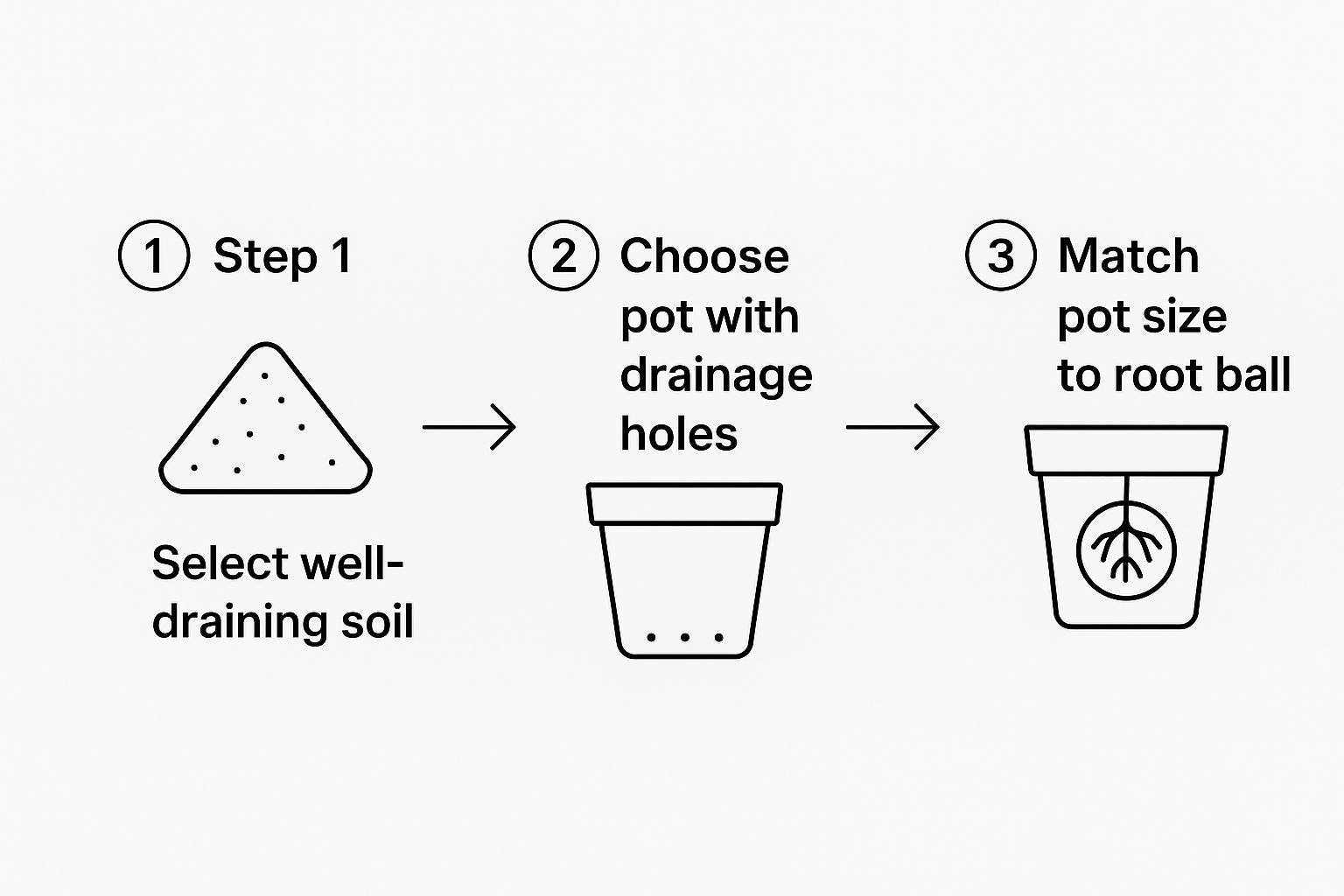
As you can see, a pot with good drainage and the right kind of gritty soil are non-negotiable. This is the foundation for properly learning how to water succulent plants and preventing the dreaded root rot before it ever starts.
Figuring Out Your Ideal Watering Schedule
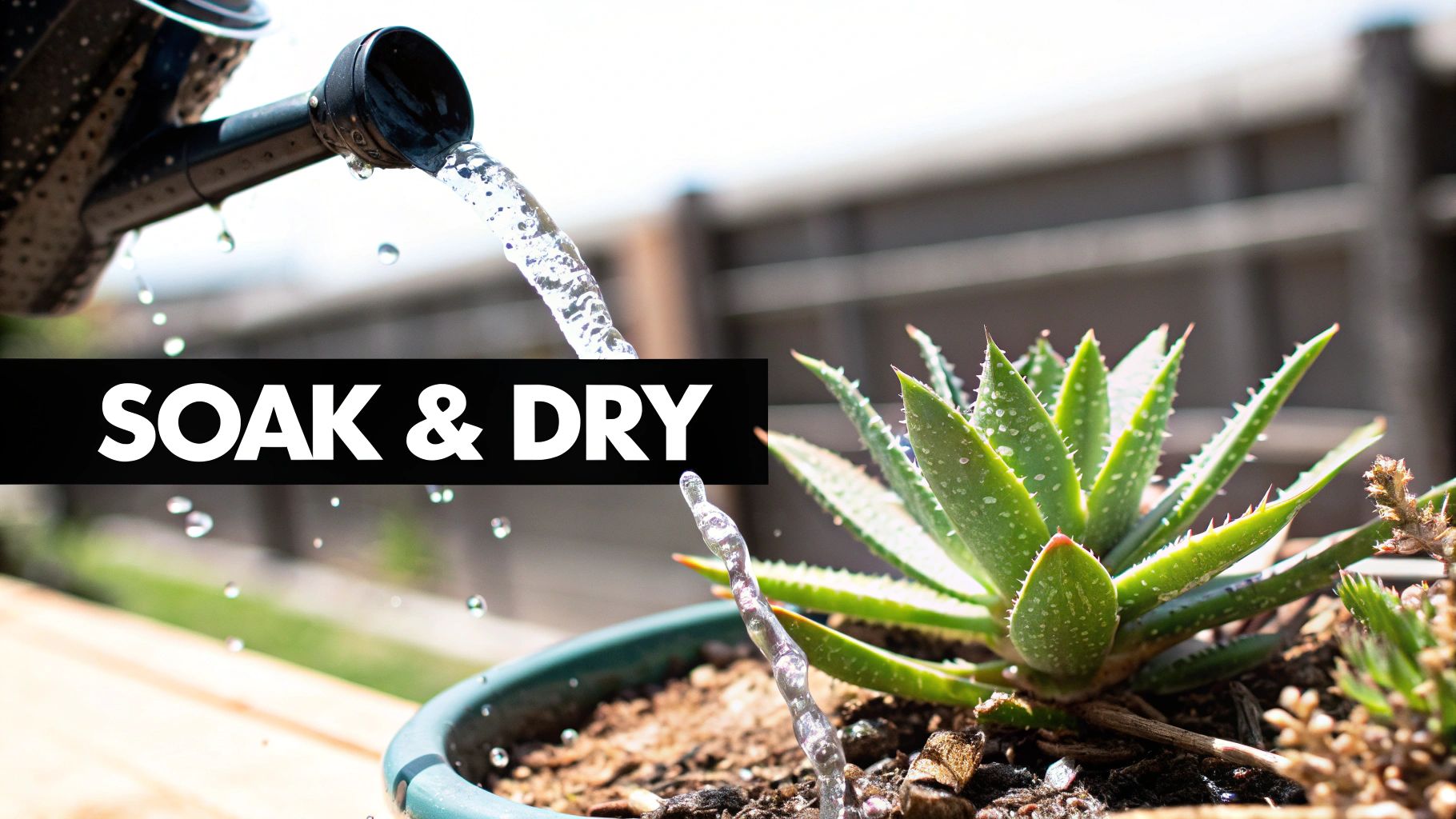
If you're asking how often to water your succulents, the most truthful answer is, "it depends." The very first thing I tell new succulent owners is to throw out their calendar-based watering schedule. These plants couldn't care less if it's Tuesday; they care about their environment.
Your real job is to learn how to read those environmental cues. Once you master that, you'll know exactly when to water. Several key factors can drastically change how thirsty your succulent gets, which is why a one-size-fits-all approach just doesn't work.
It’s a tough pill to swallow, but improper watering is the number one killer of succulents. In fact, over 60% of new owners lose plants because they get this part wrong. The golden rule is to water only when the soil is bone dry, but how quickly that happens is all over the map.
What Actually Changes Your Watering Frequency?
Forget the calendar. Your plant's thirst can change dramatically from one month to the next based on what’s happening in your home.
Here are the main variables I always check:
-
Season and Sunlight: Succulents are most active in the spring and summer. With longer days and more intense light, they're growing and using up water much faster. Come winter, when the days get short and dim, most succulents go dormant and barely need any water at all.
-
Pot Material: The pot you choose has a huge impact. Classic, unglazed terracotta is porous, meaning it breathes and lets the soil dry out quickly. On the other hand, a glazed ceramic or plastic pot will hold onto moisture for a lot longer, meaning you'll need to water far less often.
-
Humidity and Airflow: Think about location. A succulent in a steamy bathroom will stay damp way longer than one sitting in a dry, sunny living room. Good airflow from an open window or a fan also speeds up evaporation, helping the soil dry out faster.
Putting It All Together: Real-World Scenarios
Let's make this practical. Imagine you have two identical Echeverias, but they live in different conditions.
-
Scenario A (Summer): One Echeveria is in a terracotta pot on a bright, south-facing windowsill. In the middle of July, with all that sun and heat, it will probably need a deep soak every 10 to 14 days.
-
Scenario B (Winter): Its twin is in a glazed ceramic pot, sitting on a bookshelf across the room in January. This plant is basically hibernating. It could easily go a full month, maybe even longer, without needing a single drop.
Same plant, totally different needs. This is the secret to happy succulents. This principle holds true for their spiky cousins, too, which you can learn more about in our guide on how often you should water a cactus.
Reading the Signs: Is Your Succulent Thirsty or Drowning?
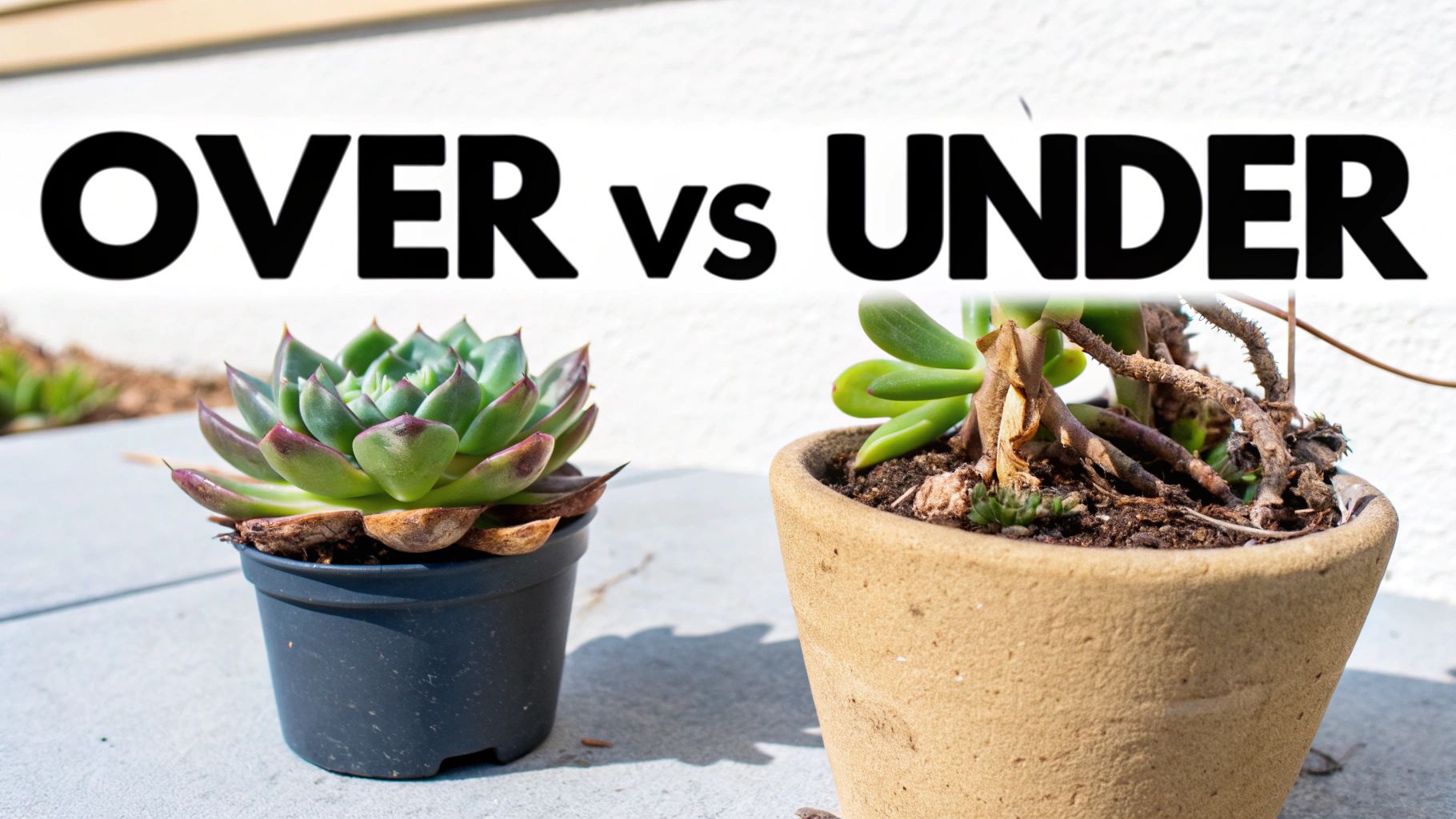
Succulents are pretty good at telling you what they need, but you have to know their language. Learning to spot the early warning signs of a watering problem is the single best skill you can develop to keep them healthy. The two biggest culprits, overwatering and underwatering, look surprisingly similar at first glance but have very distinct tells.
When you've given a succulent too much water, its cells literally swell to the bursting point. This is when you'll see those classic soft, mushy leaves. They might even look a bit translucent or swollen. The most telling sign? The leaves turn yellow and fall off with the slightest nudge. That’s a huge red flag that root rot has likely set in below the surface.
An underwatered succulent, on the other hand, just looks parched and sad. The leaves lose their firmness and feel soft and flimsy instead of plump. You'll notice wrinkling or shriveling, which usually starts with the lowest leaves as the plant sacrifices them to conserve moisture for new growth.
Overwatering vs Underwatering Symptoms
It's easy to get confused since both issues can lead to soft leaves. The real difference lies in the details—the color and texture tell the whole story. An overwatered leaf is mushy and yellowed, while an underwatered one is just wrinkled and dull.
This chart breaks down what to look for side-by-side.
| Symptom | Overwatered Succulent | Underwatered Succulent |
|---|---|---|
| Leaf Texture | Mushy, soft, and swollen | Wrinkled, deflated, and limp |
| Leaf Color | Yellow or translucent | Dull, may appear faded |
| Leaf Drop | Leaves fall off easily with a light touch | Lower leaves dry up and become crispy |
| Stem | May appear black or soft at the base (rot) | Can look shriveled or thin |
A struggling plant is just asking for a little help, not a one-way ticket to the compost bin.
Don't panic if you see a problem. A wilting plant isn’t a lost cause; it’s just asking for a change. Acting quickly based on these signals can save your succulent and help you refine your watering technique.
The Rescue Mission: How to Step In
Once you've figured out what's wrong, it's time to act.
-
If it's overwatered: Stop watering immediately. If the soil is completely waterlogged, your best bet is to gently slide the plant out of its pot. Let the root ball air out for a day or two, then trim away any roots that look black or feel mushy. Repot it in fresh, dry soil designed for succulents.
-
If it's underwatered: This is an easier fix! Just give it a really good, deep drink using the "soak and dry" method we talked about. Put the pot in the sink and let water flow through until it's completely saturated. The leaves should start to plump back up within a day or two.
Learning these distress signals is a core part of figuring out how to water succulent plants the right way. It takes the guesswork out of the equation and lets you give your plants exactly what they're asking for.
Why Your Pot and Soil Are Critical for Success
You can follow the "soak and dry" method perfectly, but it won't matter one bit if your succulent's home isn't set up for success. I can't stress this enough: the two absolute must-haves for a thriving succulent are a pot with drainage and the right kind of soil. It's the foundation of everything.
If your pot doesn't have a drainage hole, it's a no-go. Seriously. That little hole is an escape route for any extra water, preventing the soil from turning into a swampy mess that leads to root rot. A pretty pot without a hole is just a death trap waiting to happen.
Choosing the Right Soil Mix
Just as important is what you're planting in. Regular old potting soil is a disaster for succulents. It's too heavy and holds onto moisture for way too long, basically suffocating the roots.
Succulents evolved in arid places, so they need a gritty, fast-draining soil that mimics that environment. That’s why you’ll always see ingredients like perlite, pumice, or coarse sand in good succulent mixes.
These gritty bits create tiny air pockets in the soil. This allows water to drain right through and gives the roots room to breathe. Getting the soil right is your best insurance policy against overwatering.
If you're a DIY type, you can get the full scoop on mixing your own in our guide to the perfect cactus and succulent soil.
Getting this setup right isn't just about plant health; it's also about water conservation. Gardens that feature succulents can slash their irrigation needs by up to 75%. That's a huge deal, especially in drier climates. For more on this, you can dig into the data on succulent water efficiency on verifiedmarketresearch.com.
Common Questions About Watering Succulents
Even after you’ve got the basics down, a few tricky questions always seem to pop up. Let's tackle some of the most common dilemmas I hear from succulent growers so you can handle these situations like a pro.
Is Misting Good for Succulents?
Let's clear this one up right away: never mist your succulents. This is probably the most common (and harmful) myth out there. Misting leaves water droplets on the leaves and in the plant's rosette, which is a perfect recipe for rot and fungal issues.
It also does absolutely nothing to hydrate the roots where the plant actually absorbs water. Stick to watering the soil, not the plant.
The bottom line is simple: misting does far more harm than good. It's the opposite of the deep "soak and dry" cycle succulents have evolved to expect, setting them up for failure.
What’s the Best Type of Water to Use?
If you want to be an A+ student, rainwater or distilled water is the absolute best. They're pure and free of the minerals found in tap water that can build up in the soil over time.
That said, for most of us, regular tap water works just fine. If you live in an area with particularly "hard" water, a good trick is to let it sit out in an open container for 24 hours before you water. This lets some of the chlorine evaporate.
Can I Plant Succulents in a Pot Without a Drainage Hole?
I get it, you found the perfect cute pot, but it doesn't have a hole. While it’s tempting, I strongly advise against it. A pot without drainage is a death trap for a succulent, plain and simple. Water pools at the bottom, and the roots are guaranteed to rot.
You may have heard of putting a layer of rocks at the bottom for "drainage," but that's another myth—it just raises the soggy part of the soil closer to the roots.
If you're completely in love with the pot, your best bet is to use it as a decorative "cache pot." Keep your succulent in a plastic nursery pot with drainage, and just slip that inside the nicer pot. If you absolutely must plant directly in it, use a tiny amount of water and make plans to repot it into a proper container as soon as you can.
Ready to start or expand your collection? The Cactus Outlet has a stunning variety of healthy, beautiful succulents and cacti waiting for a new home. Explore our collection and find your perfect plant today


